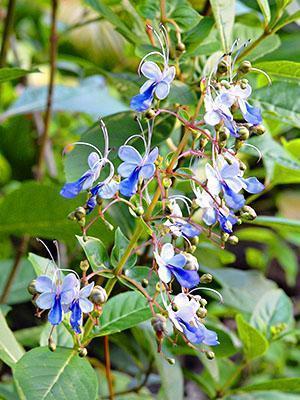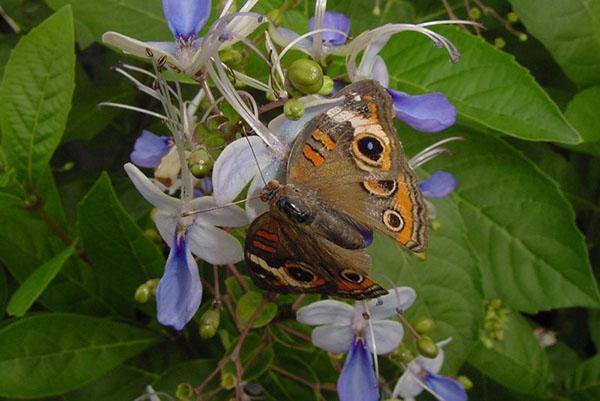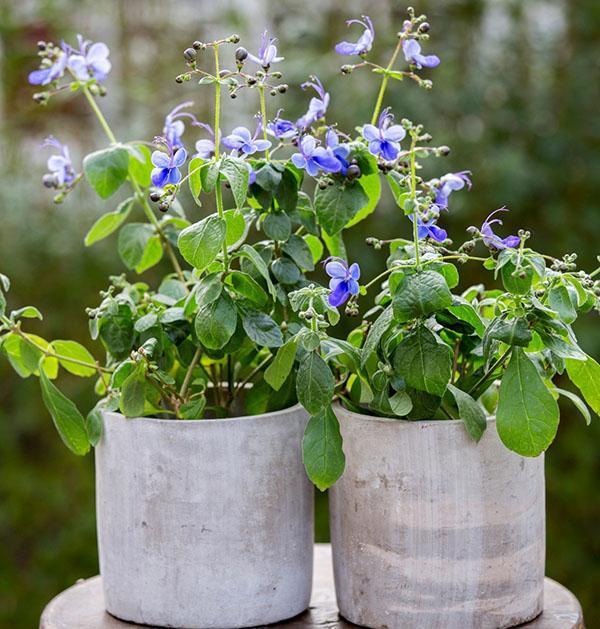The attention of flower growers is attracted by blue moths on the greenery of the Ugandan clerodendrum
 Among domestic plants, there are many people from distant countries, differing from the species of the middle lane in the whimsical forms and colorful flowers. No exception - Ugandan Clerodendrum, a representative of the flora of East Africa.
Among domestic plants, there are many people from distant countries, differing from the species of the middle lane in the whimsical forms and colorful flowers. No exception - Ugandan Clerodendrum, a representative of the flora of East Africa.
In nature, the culture looks like an evergreen shrub with long shoots sometimes reaching two meters in length. As it grows, the woody stems are thin enough and, climbing on neighboring plants or other objects, transforms the clerodendrum into a graceful vine.
The species is easy to recognize:
- on pointed-elliptical, slightly wrinkled green leaves;
- medium-sized, but very attractive blue flowers, reminiscent of butterflies sitting down to rest.

In the southern regions, where winter temperatures allow, the culture can be grown in the open air, in the middle lane, Ugandan Clerodendrum is grown at home, and plant care is within the power of both experienced and novice growers.
Growing conditions for Ugandan Clerodendrum
 Despite the exotic appearance and origin at home, Clerodendrum Ugandan is a liana that is easy to maintain, but not yet very well known to Russian flower growers.
Despite the exotic appearance and origin at home, Clerodendrum Ugandan is a liana that is easy to maintain, but not yet very well known to Russian flower growers.
The main conditions for successful plant growth are:
- choosing a well-lit place for a flower;
- in creating a kind of wintering with a decrease in the temperature of the content;
- maintaining high humidity;
- in abundant watering;
- in mandatory pruning;
- in transplant to support the development of a large ornamental crop.
The plant is not afraid of bright light, therefore, Ugandan Clerodendrum, as in the photo, can be grown without fear for the well-being of a flower on windows facing not only east or west, but also south. But the north side is destructive for the decorative look. Although the stems will grow, they become thinner, internodes become longer, and flowering may not wait at all.
If you cannot find a suitable place for culture, it is more correct to use special lamps and additionally highlight the pot with the Ugandan guest.
 Clerodendrum has no special requirements for temperature conditions. In the warm season, the plant is content with the room atmosphere, it feels great when the pot is taken out to the loggia or in the garden.
Clerodendrum has no special requirements for temperature conditions. In the warm season, the plant is content with the room atmosphere, it feels great when the pot is taken out to the loggia or in the garden.
But to lay the buds, the Ugandan Clerodendrum needs a cool wintering. For 2-3 months the container with a flower is taken out into a room with an air temperature of 12-16 ° C. If this is not done, the bloom will be seriously damaged, as with excessively dry air. At home, the flower is regularly sprayed with warm, settled water and in every way increase the content of water vapor in the atmosphere. See: oleander photo!
Features of caring for Ugandan Clerodendrum
 During the period of growth and mass flowering, the Ugandan clerodendrum, when leaving, requires frequent and abundant watering with soft, settled water.The frequency with which it is necessary to moisten the soil depends on the rate of drying of the substrate on the surface. The plant tolerates dry soil well and quickly restores the shortly lost turgor, but excessive moisture inside the substrate can be fatal for the culture.
During the period of growth and mass flowering, the Ugandan clerodendrum, when leaving, requires frequent and abundant watering with soft, settled water.The frequency with which it is necessary to moisten the soil depends on the rate of drying of the substrate on the surface. The plant tolerates dry soil well and quickly restores the shortly lost turgor, but excessive moisture inside the substrate can be fatal for the culture.
After flowering, clerodendrum can be watered less. And during the dormant period, when the plant is cool, this should be done extremely rarely, and very carefully, trying to only slightly moisten the earthy lump.
The feeding regime of the Ugandan clerodendrum, in the photo, differs little from similar care for other flowering plants. At home, twice a month make complex product for ornamental crops.
At the beginning of the growing season, top dressing may contain an increased amount of nitrogen, which stimulates the growth of greenery and shoots. And by the summer, it is more correct to use drugs with a predominance of potassium and phosphorus. In this case, Clerodendrum will give the maximum number of flowers and grow well.
 Young plants do not require special pruning, but as soon as the clerodendrum is given several long shoots, the question arises about the need to maintain the shape of the crown. In nature, the stems of this culture grow up to 2 meters in length. At home, caring for a Ugandan Clerodendrum of this size will not be easy.
Young plants do not require special pruning, but as soon as the clerodendrum is given several long shoots, the question arises about the need to maintain the shape of the crown. In nature, the stems of this culture grow up to 2 meters in length. At home, caring for a Ugandan Clerodendrum of this size will not be easy.
In spring, before the start of active vegetation, and in autumn after the inflorescence wilting, the shoots are shortened to half the length. This procedure makes it possible to induce tillering of the plant and increase its decorative effect due to the buds formed on the tops of young stems.
 Using pruning, experienced florists turn an ornamental crop into a compact standard tree. For this, a trunk is formed from a strong shoot, sequentially cutting off all the lateral branches and providing the Ugandan clerodendrum with additional support. Then the stem is pinched, and a crown is created from the young branches starting to grow.
Using pruning, experienced florists turn an ornamental crop into a compact standard tree. For this, a trunk is formed from a strong shoot, sequentially cutting off all the lateral branches and providing the Ugandan clerodendrum with additional support. Then the stem is pinched, and a crown is created from the young branches starting to grow.
Transplantation and reproduction of Ugandan Clerodendrum
The African plant needs a nutritious, slightly acidic substrate, excluding the possibility of moisture stagnation. The easiest way to plant and further care for Ugandan Clerodendrum is to purchase ready-made soil for flowering home crops and add a little crushed bark to it and charcoal.
The plant belongs to a fast-growing species and requires rather frequent transfer to a container with a larger diameter. If over the summer the bush has greatly increased in growth, you should not deny him a new pot. You can transplant clerodendrum both in spring and autumn.
Pruning at the same time can provide excellent planting material for shrub propagation. These are apical cuttings that are rooted in water and planted in a loose, lightweight substrate. Already in the second year, such plants are ready to bloom and delight the owner with flocks of blue moths over luscious greenery.